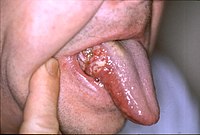
Sequential Ipilimumab After Chemoradiotherapy in Curative-Intent Treatment of Patients With Node-Positive Cervical Cancer.
Sign Up to like & getrecommendations! Published in 2019 at "JAMA oncology"
DOI: 10.1001/jamaoncol.2019.3857
Abstract: Importance Despite standard chemoradiotherapy (CRT), most women with lymph node (LN)-positive cervical cancer experience disease recurrence. Immunotherapy is being investigated in the up-front treatment setting. Objectives To assess the safety of sequential immunotherapy after CRT… read more here.
Keywords: treatment; node positive; cervical cancer; ipilimumab ... See more keywords

Suppression of miR-93-5p inhibits high-risk HPV-positive cervical cancer progression via targeting of BTG3
Sign Up to like & getrecommendations! Published in 2018 at "Human Cell"
DOI: 10.1007/s13577-018-00225-1
Abstract: This study explores the role of miR-93-5p in high-risk HPV-positive (HR-HPV) cervical cancer by targeting of BTG3. Cervical tissues were collected from 332 patients with conditions of chronic cervicitis (n = 42), low-grade cervical intraepithelial neoplasia (CIN… read more here.
Keywords: btg3; mir; cervical cancer; cancer ... See more keywords

DNA repair gene expression is associated with differential prognosis between HPV16 and HPV18 positive cervical cancer patients following radiation therapy
Sign Up to like & getrecommendations! Published in 2020 at "Scientific Reports"
DOI: 10.1038/s41598-020-59383-8
Abstract: Cervical cancers are almost always induced by HPV infections, of which HPV16 and HPV18 are predominant. Cancers associated with these strains are induced through DNA repair factors and have a differential response to radiation therapy.… read more here.
Keywords: radiation therapy; hpv18 positive; cancer; therapy ... See more keywords

MALAT1 Inhibits Proliferation of HPV16-Positive Cervical Cancer by Sponging miR-485-5p to Promote Expression of MAT2A.
Sign Up to like & getrecommendations! Published in 2021 at "DNA and cell biology"
DOI: 10.1089/dna.2020.6205
Abstract: Cervical cancer is the leading cause of morbidity and mortality in women throughout the world, human papillomavirus 16 (HPV16) is the main type of HPV causing invasive cervical cancer. However, the underlying mechanism of the… read more here.
Keywords: mat2a; cervical cancer; hpv16 positive; cancer ... See more keywords

MicroRNA-18a targeting of the STK4/MST1 tumour suppressor is necessary for transformation in HPV positive cervical cancer
Sign Up to like & getrecommendations! Published in 2020 at "PLoS Pathogens"
DOI: 10.1371/journal.ppat.1008624
Abstract: Human papillomaviruses (HPV) are a major cause of malignancy worldwide. They are the aetiological agents of almost all cervical cancers as well as a sub-set of other anogenital and head and neck cancers. Hijacking of… read more here.
Keywords: cervical cancer; stk4; cancer; hpv positive ... See more keywords

New therapeutic approaches in the treatment of node-positive cervical cancer patients based on molecular targets: a systematic review.
Sign Up to like & getrecommendations! Published in 2019 at "Ginekologia polska"
DOI: 10.5603/gp.2019.0062
Abstract: Cervical uterine cancer is the second most frequent female cancer worldwide and a substantial burden for low-income societies and the patients themselves. Understanding the molecular mechanisms of metastasis permits the development of therapies that limit… read more here.
Keywords: metastasis; treatment; cancer; positive cervical ... See more keywords